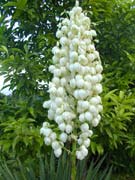 |
|
Golden and Green Bamboo |
Botanists often classify plants into categories according to their life span. They name plants that can complete their life circle within one year as annual plants, plants that complete their life circle in two years as biyearly plants, and plants that complete their life circle in three years or above as vivacious plants. Woody plants, no matter shrubs, vines or arbors, are almost all vivacious plants. Since annual and biyearly plants only blossom and fructify one time each year, they are also called monocarpic plants; while vivacious plants, since they all bloom and fructify many times in their life time, all belong to polycarpic plants.
 |
|
African Wine Palm |
Plants grow in tropical areas often have different features from those growing in other climate zones. Here, some plants with long life spans only blossom and fructify one time before they die.
Agave Americana and A. sisalana are meaty plants growing in dry tropical areas, and they will die away after they blossom and fructify one time. Bamboo is a kind of vivacious woody plant, after they grow many years, they will die away after they blossom and fructify. Nowadays, people get to know more about this phenomenon. However, in the tropical rain forests, some tall arbor plants, also die away after they blossom and fructify one time; and this is little known to common people.
Caryota urens is a kind of palm plant in the rain forest of Xishuangbanna. After growing for dozens of years, they can grow as thick as 70-80 cm, and as tall as 10 meters or above; then, they will grow out anthotaxy and will become withered after that.
Corypha umbraculifera, which is as tall as caryota urens, is also a kind of monocarpic plant, only that its life span is about 10 years longer than that of
caryota urens.
 |
 |
|
Talipot Palm |
A. sisalana |
The growth of plants has close relations with their system development and ecological environment. So far as plant classification is concerned, the above-mentioned monocarpic plants all belong to endogens; and they are more evolved than
dicotyledon of the angiosperm and gymnosperm family. Why can't we find such a phenomenon in other vivacious plants or arbors? Does this prove that monocarpic plant is more capable to adapt to the changes in environment? The encyclopedia of the rain forest always leave human beings some difficult riddles, and we must continue our investigation if we want to find the correct answer.
 
|